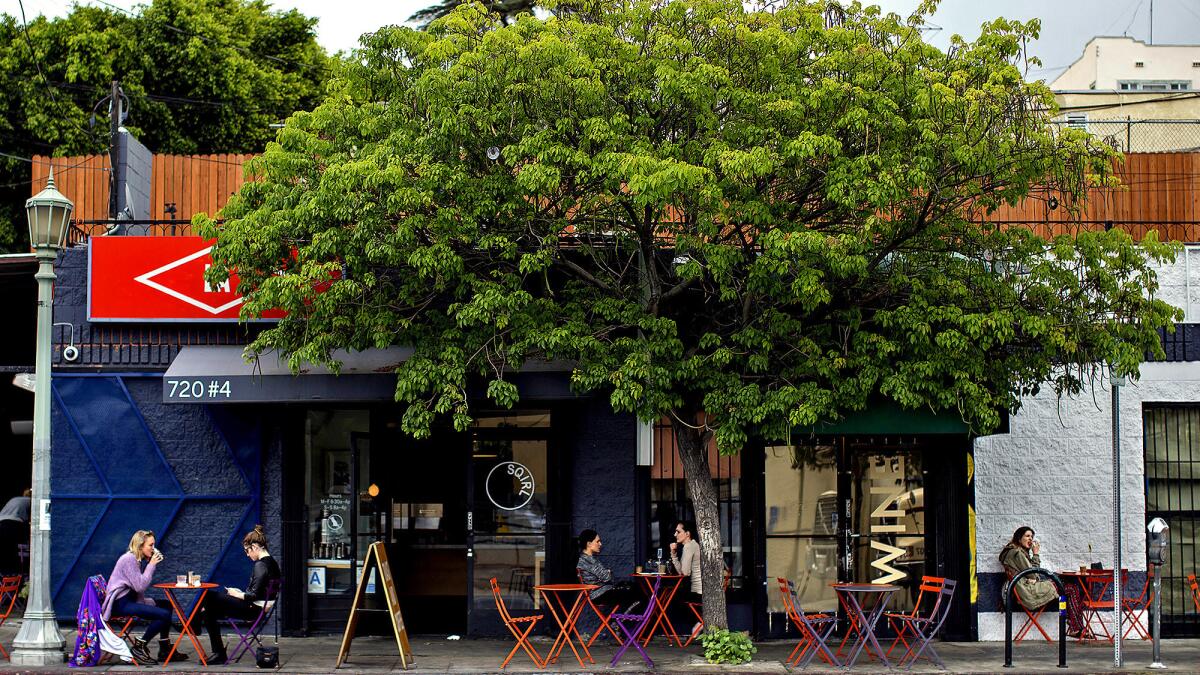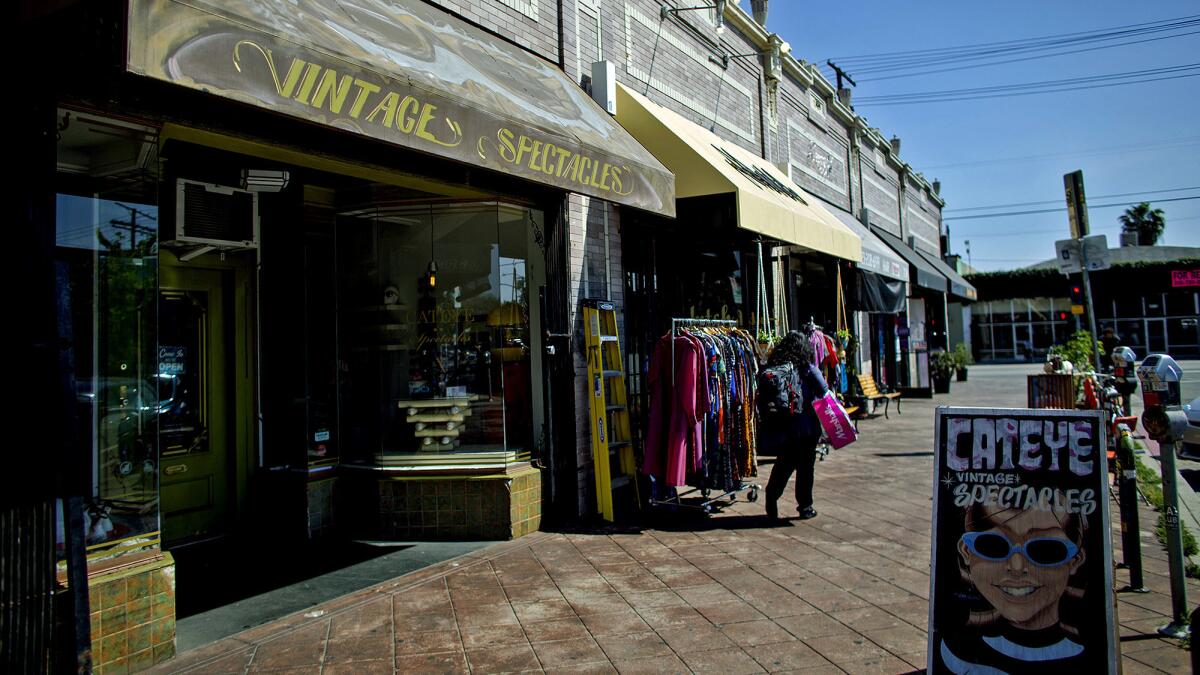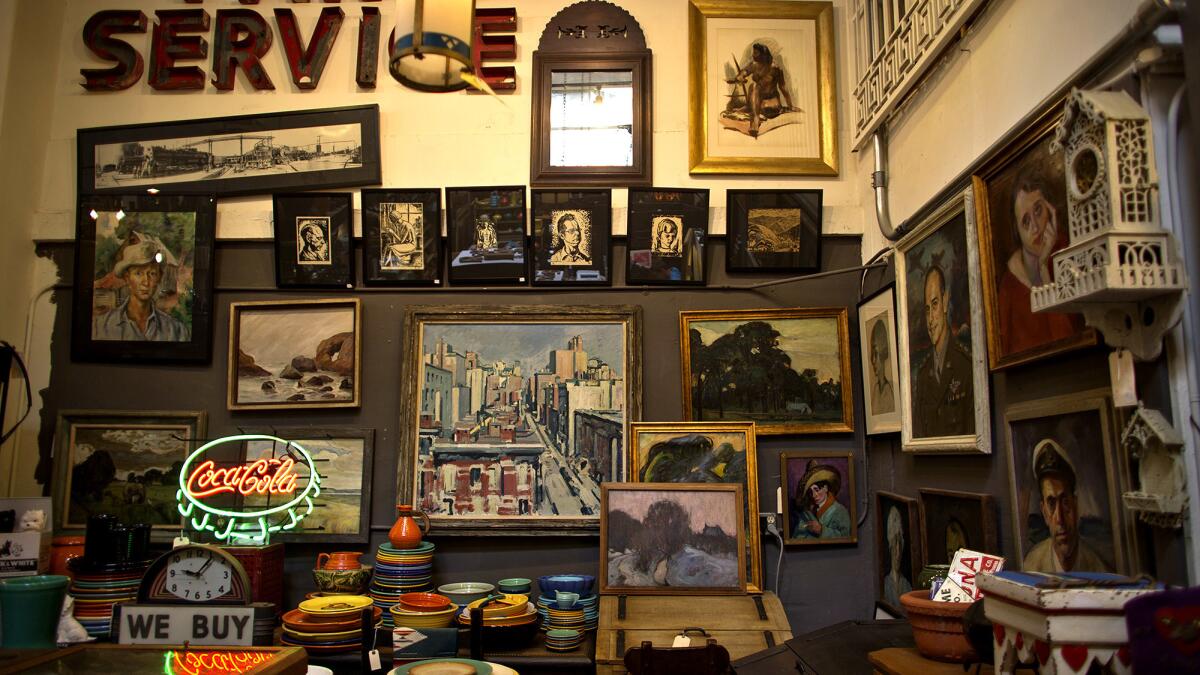Neighborhood Spotlight: East Hollywood is a diverse, affordable spot that’s just this side of hip

- Share via
Where one of the densest, most urban neighborhoods in Los Angeles now stands was once the small farming community of Prospect Park, which by the late 1800s boasted acres of fragrant citrus trees planted in orderly rows across gently rolling hills.
The citrus groves thrived in the shelter of the eastern end of the Santa Monica Mountains, which kept the tree-killing frost at bay during winter and were also the source of the rich alluvial soil that covered what was then known as the Cahuenga Valley.
Prospect Park was to the east of an ambitious little town known as Hollywood, to which it was connected by the tiny steam-drawn cars of the Cahuenga Valley Railroad and later by a streetcar that ran down the center of unpaved Prospect Avenue.
It was to capitalize on Hollywood’s growing popularity in the 1900s that Prospect Park’s town leaders decided to re-christen their settlement as East Hollywood. When both towns eagerly agreed to annexation by the city of Los Angeles in 1910, most of Prospect Avenue was renamed Hollywood Boulevard.

The name was gone, but the same endless supply of sunshine that made Southern California ideal for farming also made it ideal for making silent movies, which relied on the sun for lighting and were filmed on open-air stages.
Arrayed along the 1.5-mile stretch of Sunset Boulevard between Western Avenue and Hoover Street were the studios where D.W. Griffith shot many of his masterpieces, Charles Fox launched the precursor to 20th Century Fox and the actor Charles Ray continued to build out what would later become the KCET studios.
Institutions flocked to the area as well: Children’s Hospital Los Angeles moved to Sunset Boulevard in 1914, with Hollywood Presbyterian, Cedars of Lebanon and Kaiser Permanente’s Los Angeles Medical Center eventually following suit.
Stunning photos, celebrity homes: Get the free weekly Hot Property newsletter »
Downtown’s Normal School moved to a campus on Vermont Avenue, which soon became the first home of what would become UCLA. And on a knoll overlooking Hollywood Boulevard, oil heiress Aline Barnsdall created an art park that features Frank Lloyd Wright’s Hollyhock House and outbuildings by Rudolph Schindler and Richard Neutra.
Today, East Hollywood is known for its rich cultural diversity. Little Armenia and Thai Town are just blocks apart, the Ukrainian Cultural Center is here as well, and the neighborhood has long been home to a vibrant Latino community.
Neighborhood highlights
Global cuisines on a budget: From the original Zankou Chicken to hangover spot El Gran Burrito and every kind of joint in between (Pa Ord Noodle, we’re looking at you), East Hollywood’s got great eats at low, low prices.
The (housing) price is right: Surrounded by more expensive neighborhoods, East Hollywood offers access to hip enclaves at a lower price point.
Commuter connections: The real action in East Hollywood is on rails. With three Metro stations in the neighborhood, downtown, the Westside and the Valley are just a train ride away.

Neighborhood challenges
The road to recovery is long: Damage to local businesses during the ’92 riots dealt a blow to the neighborhood’s economy, but recent reinvestments in the area, including an expansion of L.A. City College and new mixed-use housing developments, are helping to bring jobs back.
Expert insight
Redfin agent Nikki Kilmer, who lives just west of East Hollywood, has seen big changes in the community in recent months. “My favorite corner is Melrose and Western,” she said. “There was nothing there three months ago, but now there is street art and new restaurants.”
As for housing, Kilmer said the area is definitely more geared toward renters.
“The neighborhood is so central, you can get to downtown, Silver Lake or West Hollywood in minutes,” she said. “It’s a really great transitional area, particularly for people looking to save for a home or are new to the area.”
Market spotlight
Portions of the 90027 and the 90029 ZIP Codes overlap the area. In July, based on 17 sales, the median price for a single-family home was $1.255 million. In the 90029 ZIP, the median price was $617,000, based on two sales.
Report card
There are six elementary schools within the boundaries of East Hollywood. Among them is Harvard Elementary, which scored 829 out of 1,000 in the 2013 Academic Performance Index. Lexington Avenue Primary Center had a score of 801, and Kingsley Elementary scored 788.
Nearby schools include Thomas Starr King Middle and Virgil Middle, which scored 843 and 745, respectively. Helen Bernstein High had a score of 634.
More to Read
Sign up for Essential California
The most important California stories and recommendations in your inbox every morning.
You may occasionally receive promotional content from the Los Angeles Times.






